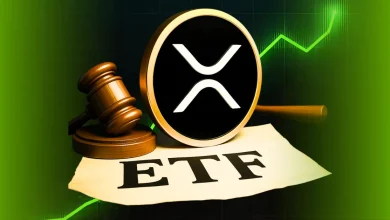
Crypto Market Hits Extreme Fear as Fear & Greed Index Drops to 25 After Trump’s Tariff Announcement.
Markets worldwide tumbled, with U.S. stocks and crypto down sharply, with $514 million in liquidations.
Trump's tariffs boost U.S. recession fears, amid rising economic concerns.
President Donald Trump’s latest tariff announcement has sent shockwaves through financial markets, triggering panic among investors. The crypto market, which had been holding steady, has now plunged back into a state of “extreme fear” as uncertainty takes over.
The Fear and Greed Index, a key measure of market sentiment, dropped by 19 points to 25 on Tuesday – its lowest level in months. With stock futures tumbling and Bitcoin struggling to hold its ground, investors are bracing for what comes next.
Trump’s ‘Liberation Day’ Spark Market Panic
The sudden decline in investor confidence comes after Trump introduced a sweeping set of new tariffs on April 2, calling it the “Liberation Day” plan. This aggressive policy imposes a 10 percent tariff on all imports, with some countries facing much higher rates:
- China: 54%
- Vietnam: 46%
- Taiwan: 32%
- India: 26%
- Japan: 24%
- European Union: 20%
Canada and Mexico are currently exempt, but that could change if existing tariffs are lifted.
These measures have raised concerns about economic instability, leading investors to move away from riskier assets like cryptocurrencies.
Crypto and Stock Markets Tumble
Financial markets reacted sharply. US stock futures fell by over 1,000 points, while the crypto market saw a significant sell-off.
- The total crypto market cap dropped 4% to $2.7 trillion
- Bitcoin surged briefly to $88,500 before falling 2% to $83,073
- Ethereum dropped 4% to $1,816
- Solana declined over 5% to $119
Global stock markets also took a hit. Japan’s Nikkei fell nearly 3%, while Hong Kong’s Hang Seng dropped 1.5%. Gold prices briefly spiked to a record $3,167 per ounce before pulling back. Meanwhile, US futures suggest more losses ahead, with the S&P 500 expected to open 3% lower and the Dow down 2.4%.
As panic spread, over $514 million in crypto positions were liquidated in just 24 hours, mostly from long trades. The CMC Altcoin Season Index fell to 14 out of 100, signaling Bitcoin’s growing dominance as investors move away from altcoins.
Market Experts Weigh In
Arthur Hayes, co-founder of BitMEX recently shared that the market isn’t reacting well to “Liberation Day.” He noted that Bitcoin’s ability to maintain a price above $76,500 until April 15, coinciding with U.S. tax day, would be a bullish sign. He cautioned investors to remain vigilant amid current market fluctuations.
Will the Federal Reserve Step In?
Concerns over a possible US recession have intensified following Trump’s tariff plan. Prediction markets like Polymarket show increasing worry about its economic effects.
Some analysts believe the tariffs may have a short-term negative impact but could eventually lead the Federal Reserve to cut interest rates. Joseph Wang of FedGuy.com explained that while tariffs can temporarily increase inflation, their effects can be offset by currency movements. However, he warned that declining business confidence and potential job losses could have lasting consequences, something the Federal Reserve may try to prevent.
Bitcoin Needs a New Spark
With Bitcoin struggling to regain upward momentum, experts believe it needs a new catalyst to drive prices higher. The recent turmoil highlights how quickly global events can impact cryptocurrency markets, increasing volatility.
For now, investors are closely watching the Federal Reserve, stock market movements, and Bitcoin’s key price levels in the coming weeks.
Never Miss a Beat in the Crypto World!
Stay ahead with breaking news, expert analysis, and real-time updates on the latest trends in Bitcoin, altcoins, DeFi, NFTs, and more.
FAQs
Trump’s tariffs triggered market fear, causing Bitcoin to drop 2% and crypto liquidations to hit $500M as investors moved to safer assets.
China faces the highest tariff at 54%, followed by Vietnam (46%), Taiwan (32%), India (26%), Japan (24%), and the EU (20%).
Some experts warn tariffs may hurt business sentiment and jobs, though potential Fed rate cuts could offset short-term economic damage.







